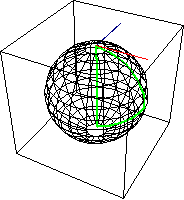经典物理中,在描述波(平面波或者球面波等等)的时候,所谓的相位一般是波矢与时空坐标的内积,因此平面波的相角事实上是依赖于坐标系的选取的,从这个意义上来讲,它不是一个好的可观测量,但局域上来讲却是可以说它是个可观测量的。 量子理论中,波函数的相位事实上代表一个事实:实数已经不能描述量子系统,必须引入复数,引入复数之后,可观测的量仍然是在实数域上取值,也就是所谓的左右dirac括号夹一下出的本征值才是可观测量。因此波函数的经典理解是它有一个纯几何学的相,是一个不可观测量,这一点就带来了所谓的薛定谔猫以及EPR佯谬。 但是,如果对量子力学系统做二次量子化,也就是量子场论来说,这种几何学的相位很可能会变成物理的相位,也就是规范场的A-B效应,此时,它是一个良好的可观测量。一般来讲,我们称之为Berry相。在人们没有认识到物理相的存在之前,人们普遍认为矢势A是没有可观测效应的(这也就是为啥它叫规范场),但A-B效应却指出,在规范场中的带规范对称性的荷的粒子如果回转一周会产生一个可观测的相移(可以通过左右手旋光通过磁场然后重新混合看是否仍为输入的圆偏振光来观测)。此时,这个问题就会变得很有意思,虽然规范场本身是非局域可观测的量,但它的非局域效应,一般数学上称为Holonomy,物理上叫Wilson loop,却是一个很好的可观测的量。 Berry相的出现可以说是理论物理学的一个分水岭,由此产生的分数霍尔效应,分数统计物理,拓扑相变等等可以说是改变了物理学的框架
Holonomy Group

On a Riemannian manifold
Since parallel transport preserves the Riemannian metric, the holonomy group is contained in the orthogonal group
A Kähler manifold is a
On a flat manifold, two homotopic loops give the same linear transformation. Consequently, the holonomy group is a group representation of the fundamental group of
No comments:
Post a Comment